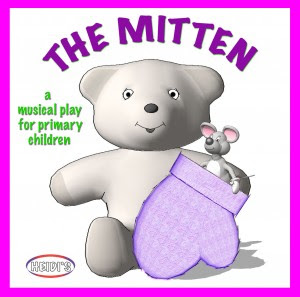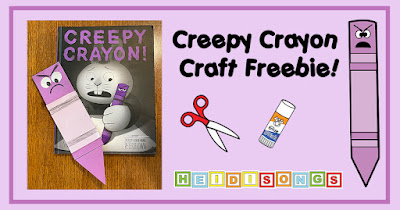How to Teach Critical Thinking Skills to Young Children (Freebie!)
Have you heard the news? We've Moved to HeidiSongs.tv!
Our new website features an online video streaming service, updated blog posts at Heidisongs.blog, and a wealth of fresh resources designed to make learning even more fun and engaging.
You can also continue shopping for our educational products there and at our Teachers Pay Teachers store!
Head over to HeidiSongs.tv now and explore all the exciting new features.
See you there!
__________________________________________________________________________
Hello, everybody! And happy summer! In this post, I am going to show you how to teach some basic critical thinking skills to young children in a way that they can easily understand. Explaining things such as inference, prediction, cause and effect, and forming opinions to children as young as Kindergarten and first grade is really not as hard as you might think! In fact, many of the thinking skills that are expected of children these days are questions that might actually come up in natural conversations, anyhow! I think that you will be pleased to find that you are already doing most of this "instinctively" already. So read on and get ready to give yourself a pat on the back!
If you find that you are already asking most of these types of questions already, then you are doing great! Now just label what you are actually doing (as far as critical thinking skills are concerned) in your mind, and find a way to remind yourself to ask those types of questions deliberately and regularly. There are different ways to do this, but my favorite way is to keep Critical Thinking Question Cards (or cards with sample questions) near the chair that you usually sit in when you read to your students, since questioning students during literacy times is a natural time to pull in those critical thinking skills.
Teaching children to answer critical thinking questions about stories that are read aloud to them is a win-win situation, especially when you consider that discussing these questions with the children will surely enhance their listening comprehension in general, PLUS they'll be working on their oral language skills, too! I always tell the kids that these thinking games are GREAT, because there really are no wrong answers, except simply refusing to try. The worst thing they could really say is nothing. Even a silly answer is better than no answer at all! Then they just need to try to explain why they think so, supporting their reasons (hopefully) with information they learned from a text or from their life experiences.
Kids get used to there being just one right answer, and the rest of the answers are wrong. But that is not the case with critical thinking activities, and that is GOOD! Here is one great little questioning trick that helps encourage children to keep thinking when they say that they do not know the answer. Just say, "If you did know, what would you say?" This came from a post in a blog called The Cornerstone for Teachers. (Sorry, I can't seem to find the exact post at the moment, so I linked to the home page.) I think that Angela, the author, also mentioned that she asks children sometimes to tell them what "one of the other kids would say, if they knew." That relieves the child of the pressure to get it right; he is just answering for someone else, LOL!
The biggest obstacle is really just a matter of getting used to these "Fancy Pants Words" in relationship to KINDERGARTEN or FIRST GRADE and realizing that YES: you CAN explain them to your little ones, and YES- many of them will be able to answer your questions. Just bring it down to their level, which is the key to teaching anything to young children- breaking things down to their most basic and tiniest steps. Teachers and parents of young children do this all the time! Why should thinking skills be so much more intimidating or different? I think I can, I think I can, I think I can....
Here is a little downloadable graphic on how to explain critical thinking skills to young children that I created to help you along. You can download it here.
This is how I think about each of the critical thinking skills below, at least in relationship to the early childhood classroom.
Hypothesize: Take a really smart guess, based on what you already know.
Example: Why do you think that foxes and wolves always seem to be the bad guys in story books?
Develop a Logical Argument: Tell us why you believe something is true, and really think for a minute because I'm going to ask you to tell me a lot about why you think so.
Example: What do you think would have happened to the animals in the mitten if the mouse had not decided to sit on the bear’s nose? Do you think that the mitten would have popped? Tell me more why.... Now tell me another reason why you think so.
Predict: Guess what will happen next.
Example: David just broke a vase with his baseball bat. What do you think is going to happen next?
You can get free directions to teach your kids how to draw David from the No, David! books by David Shannon here.
Cause and Effect: The cause is what started it and the effect is what happened.
Example: Roll a marble down a ramp. Ask, “What made the ball move?” (Or, what started the ball moving? That’s the cause.) What happened then? (We had a bell at the bottom of the ramp.) That’s the effect.
Infer: Look at the picture, and tell me what you think is happening and why.
Example: Show a picture of a broken window next to a baseball bat and ball, and have the children infer what happened. You could do this with nearly any pictures in books. Clifford books are great for this. The author doesn't tell you what happened; he implies it and then lets the children figure it out by looking at the pictures.
Connect the Text to Self: Has anything like this ever happened to you?
Example: The little bird is sad because he does not know who his mother is, and he feels lonely. Have you ever felt lonely?
Evaluate: Decide whether or not something was a good idea or a bad idea.
Example: The children let the Cat in the Hat in the house when their mom was not home. Was that a good idea or a bad idea? Why or why not?
You can find the instructions for this cute little Thing One and Thing Two hand print craft here.
Draw a Conclusion: Think about the WHOLE story and then tell me what you think.
Example: Is this story real or make believe? Why do you think so?
Compare and Contrast: Tell me how these things are different. Now tell me how they are the same.
Example: Look at the carrot and the pumpkin. How are they different? How are they the same?
Form an Opinion: How do you feel about this? Do you like it? Why or why not?
Example: Did you like this book? Did you not like this book? Why or why not?
------------
Would you like to bring Heidi to your school? Heidi does a presentation called Making Critical Thinking Skills "Do-able" for Young Children. Ask your administrators!
Want a set of Critical Thinking Question Stems that are perfect for the early childhood classroom? Check out Heidi's set here.
In case you haven't seen it yet, here's a song from one of our newest DVDs, Number Jumble!
- Heidi :)
----------------------------------
Follow me! Did you enjoy this post? Do me a favor and share it with your friends! And follow this blog by signing up for my email updates here, or follow on Bloglovin', or follow me on TPT! I'm also on Pinterest, Facebook, Twitter, Instagram, Google+ and YouTube, too! Don't forget to sign up for our email newsletter for special deals and promo codes that you won't find out about anywhere else.























